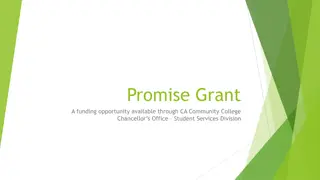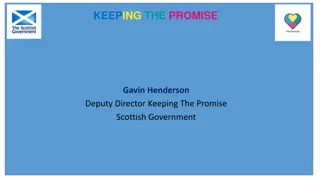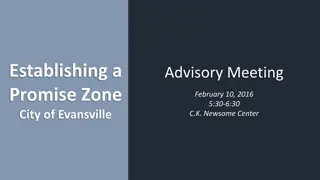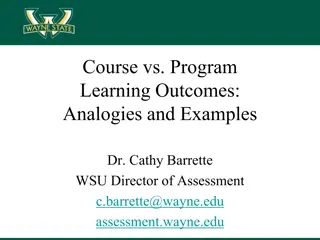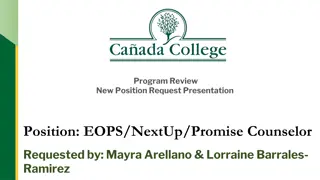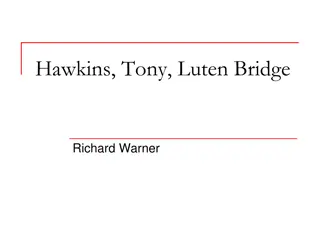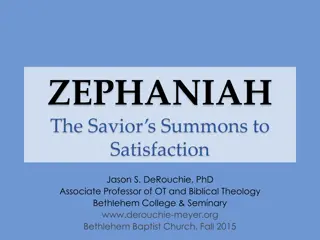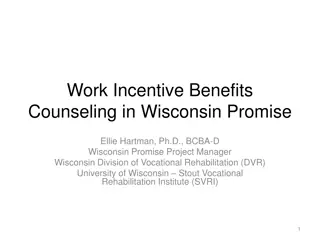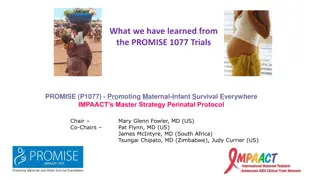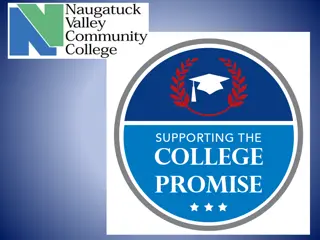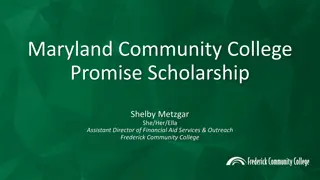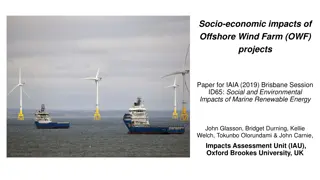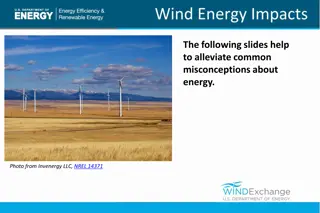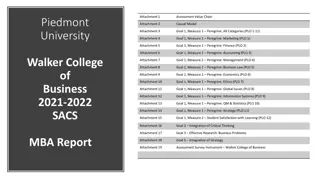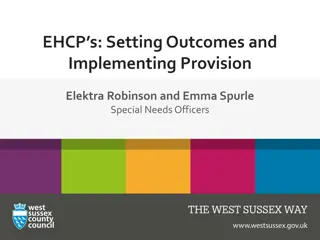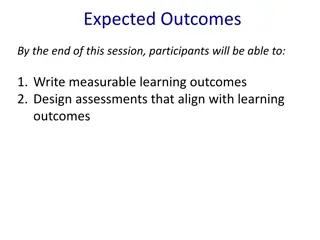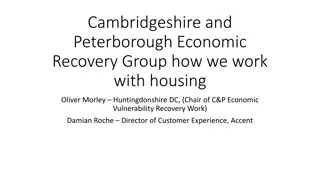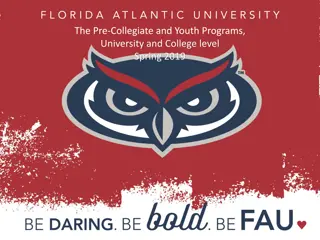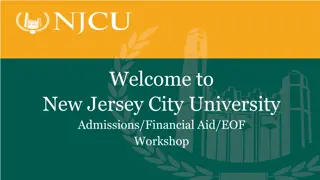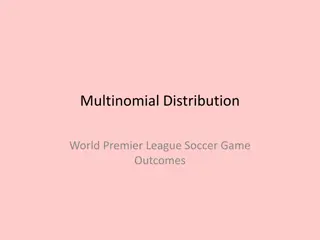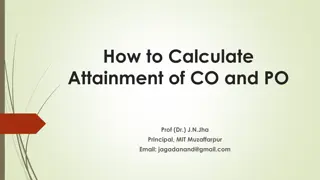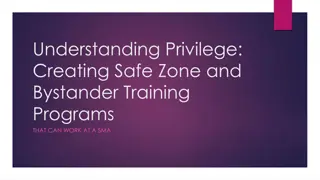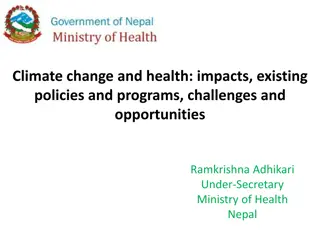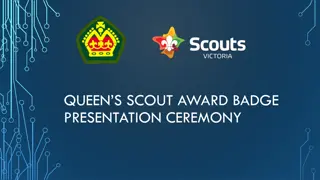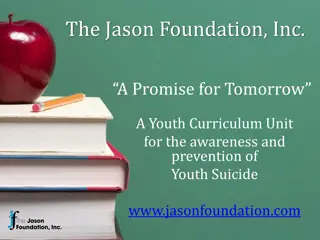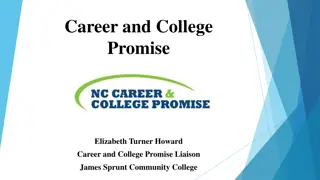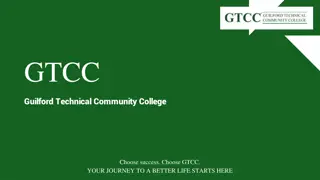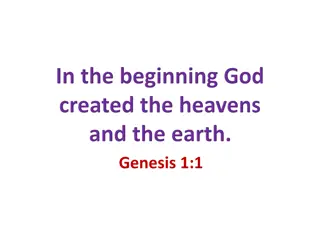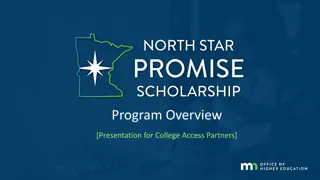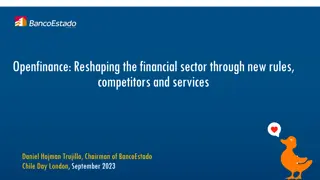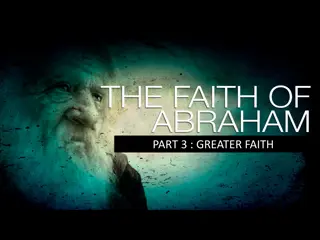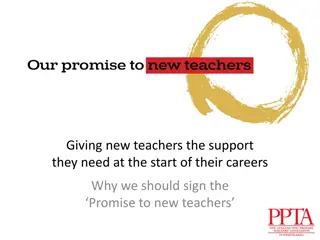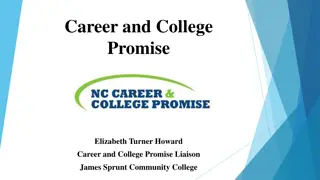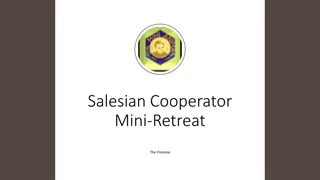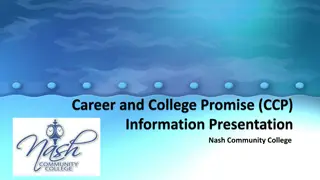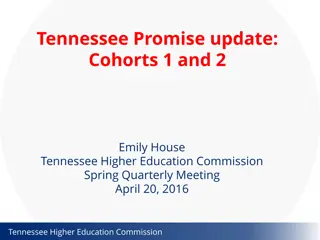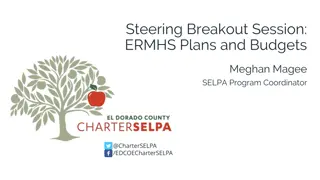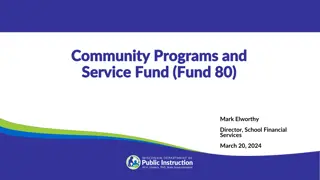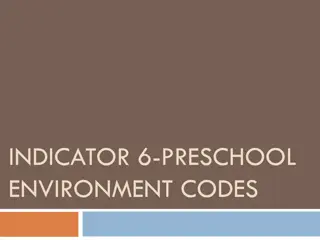Understanding Promise Programs: Structure, Impacts & Outcomes
Promise Programs are scholarship and support initiatives rooted in local communities with varying structures and eligibility criteria. While universal eligibility programs show robust outcomes, the overall success of Promise Programs depends on widespread usage and alignment with community needs, aiming to increase college access, foster college-going culture, and drive local economic development. Despite limited longitudinal data, existing programs have shown positive outcomes. Specific case studies, like the Kalamazoo Promise, highlight the impact of such initiatives on educational attainment and community growth.
Download Presentation

Please find below an Image/Link to download the presentation.
The content on the website is provided AS IS for your information and personal use only. It may not be sold, licensed, or shared on other websites without obtaining consent from the author. Download presentation by click this link. If you encounter any issues during the download, it is possible that the publisher has removed the file from their server.
E N D
Presentation Transcript
Promise Programs Structure, Impacts & Outcomes Butte College Office of Planning, Research, and Organizational Development Prepared by Emelia Michels-Ratliff 1/9/2017
Introduction & Background What is a Promise Program? Promise Programs are scholarships / support programs that are place- based in nature, made in promise to their local communities Tend to be long term in nature (1, 2 years or full tuition programs exist) Generally grassroots programs, locally funded Highly varied in structure and eligibility rules
Program Structure Most Promise Programs can be categorized according to how they determine eligibility of students and where Promise funding can be used. Student Eligibility: Universal: All students are eligible Targeted: Income or merit requirements exist Post-Secondary Options: Expansive: Funding may be used at many different schools Restrictive: Funding may only be used at one school While all program types have seen positive results, universal eligibility programs have seen the most robust outcomes.
Addressing A Need A Promise program will lead to community change only if it is widely used. Every condition or criterion added to the terms of a scholarship reduces the number of students who can use it and, hence, reduces its potential impact as a transformative tool. Michelle Miller Adams, Promise Nation: Transforming Communities through Place-Based Scholarships (2015) Promise Programs have the potential to achieve a variety of outcomes, but level of success depends on what goals are set and how structure is established with a most critical need in mind. Commonly cited overarching goals include: 1. Increasing college access among students who experience financial or support barriers 2. Increasing college-going culture, awareness, and preparation 3. Local economic and community development through increased investment in future workforce
Outcomes Because very few Promise Programs were launched prior to 2010, the amount of longitudinal data is small. However, while Promise Programs vary in their approaches, overall outcomes have been positive. The following slides display summary and highlighted outcomes by category from some of the oldest programs nationwide, as well as in California.
K-12 Impacts The Kalamazoo Promise The Kalamazoo Promise was launched in 2005 in Kalamazoo, Michigan It guaranteed scholarships to all KPS students enrolled 4+ years (at least all of high school) Between 2005 and 2013 KPS schools enrollment grew 24% Most growth is due to greater retention Source: Hershbein (2015)
K-12 Impacts The Kalamazoo Promise Days in Suspension decreased across all students after the Promise was announced and some students discovered they were eligible Among African American students, the Promise also brought a measurable lift in GPA It is notable that the Kalamazoo Promise carries no merit requirements, such as attendance or HS GPA minimums Source: Bartik and Lachowska (2015)
College Enrollment The Kalamazoo Promise Estimated increased chance of KPS student enrolling: At any college: 14% At a 4-year college: 34% Cumulative units attempted increased by 15% Source: Bartik, Hershbein, and Lachowska (2015)
College Enrollment Say Yes to Education - Buffalo: Launched in 2012, Say Yes to Education in Buffalo, NY is similar to the Kalamazoo Promise, but it is a last dollar scholarship This means that other financial aid, such as federal grants, is awarded first, and the Promise pays remaining need 12th grade to college matriculation increased post launch: Increase of 5-6% over non-promise years Gains largest at 2-year colleges Source: Bifulco, Rubenstein, Sohn, and Murchie (2016)
Persistence Ventura College Promise First established Promise Program at a CCC Promise is last dollar, one year Tuition & fees only Higher rates of persistence for Promise students compared to non-Promise students One year persistence was 13 pp higher Source: Ventura College Office of Research and Evaluation (2012)
Completion & Performance Kalamazoo Promise Completion gains in Kalamazoo after the Promise rose dramatically six years after inception: ~ A 25% increase in all award types ~ A 33% increase in Bachelor s degrees Source: Bartik, Hershbein, and Lachowska (2015)
Completion & Performance 2009 Promise cohort: Ventura College Promise Comparing similar cohorts: Ventura Promise students took more units than non- Promise students More Ventura Promise students earned degrees than non-Promise students More Ventura Promise students earned certificates than non-Promise students Ventura Promise students had slightly lower GPAs than non-Promise students, but the difference was not significant 2012 Promise cohort: Source: Ventura College Office of Research and Evaluation (2012)
Completion & Performance Long Beach College Promise Promise Non-Promise 50% Promise launched in 2008 Promise students outperform similar cohorts of non-Promise students in completion of English and math milestones 45% 46% 40% 35% 37% 30% 25% 24% 20% The Long Beach Promise Pathways combines monetary support with academic support in the form of: Multiple Measures placement Required full time enrollment Required enrollment in foundational coursework 20% 20% 19% 15% 10% 10% 9% 5% 0% Transfer Math Transfer English AA Math AA English, Math & Reading Completion Milestones within three semesters Source: LBCC Office of Institutional Effectiveness (2014)
Equity Impacts Ventura College: Promise vs Non Ventura College: Promise vs Non- -Promise Cohorts (2009) (2009) Promise Cohorts Ventura College Promise 80% By subgroup at Ventura College, more Promise participants are: Non-White Female Low or Middle Income 70% 60% 50% 40% 30% VC Promise students earning awards: Majority are low or Middle Income Larger percentages of non-White students 20% 10% 0% White Non- White Female Male Low Income Middle Income High Income Promise Non-Promise Source: Ventura College Office of Research and Evaluation (2012)
Community Impacts Multiple Promise areas Study of 8 Promise Program zones using ACS migration data (1% U.S. sample) Promise Program areas showed large reductions in out-migration, particularly for families with children In Kalamazoo: Inferred 1% increase in property values Inferred 1.7% boost to local labor market & employment Source: Bartik and Southerland (2015)
Growth in California There are now over 20 Promise Programs at California s Community Colleges! The majority of these programs: Are last dollar, after BOG and PELL Offer one year of support Many aim to eventually offer two years Offer some type of additional support, such as fee payment or vouchers for books Are universal in eligibility Are restrictive and may be used at only one campus Aim to offer not only monetary support, but increased access to academic supports such as counseling or early college tours For additional info: https://calcollegepromise.org/
Developing a Butte College Promise Area Student Eligibility & Need: Approximately 1250-1300 new students within the local service area each year Between 70-75% of these students complete a FAFSA Of those who file a FAFSA: Approximately 90% are awarded a BOG fee waiver & pay no tuition Between 60-70% are also awarded a PELL grant to help with additional costs Around 10% receive no aid Example costs not covered by BOG fee waivers: 2016-2017 estimated cost of books & supplies at Butte College: $896 / semester 2016-2017 fees for full time enrollment: $132 / semester
Developing a Butte College Promise Proposed Butte College Promise Eligibility: Be a recent HS graduate from Butte or Glenn County OR a recent HS graduate and Reg2Go participant Complete an application through CCCApply and enroll at Butte College Enroll in the fall semester immediately following high school completion Complete a FAFSA and BOG fee waiver application, or a CA Dream Act application Complete a Butte College Promise application Complete assessment, orientation and academic advising with a Comprehensive Student Educational Plan Enroll at least full time (12+ units) for the duration of the award Attend Butte College without interruption to receive funding for the duration of the award Remain in good academic standing at Butte College (GPA at or above 2.0)
Butte College Promise: Three Options Option 1 Option 2 1 Year, Last Dollar: Tuition/Fees, $500 Books Option 3 2 Years, Last Dollar: Tuition/Fees, $500 Books 1 Year, Last Dollar: Tuition & Fees only Expected Eligibility: Students with no aid- full promise (100+) BOG only students (200+) fees only BOG + PELL students (700+) $500 book voucher Total Students: 1000+ Expected Eligibility: Students with no aid- full promise (100+) BOG only students (200+) fees only BOG + PELL students (700+) $500 book voucher Total Students: 1000+ Expected Eligibility: Students with no aid- full promise (100+) BOG only students (200+) fees only Total Students: 300+ Anticipated Annual Cost: $108,000 / Year Anticipated Annual Cost: $365,000 / Year Anticipated Annual Cost: $615,000 / Year


